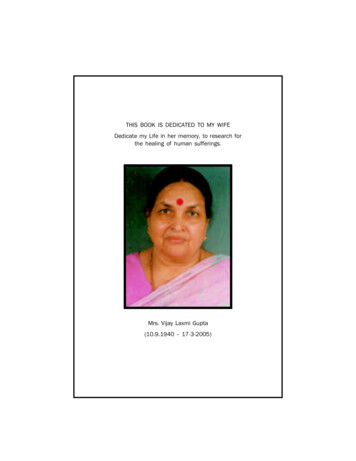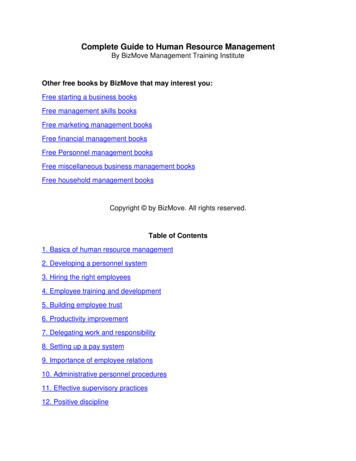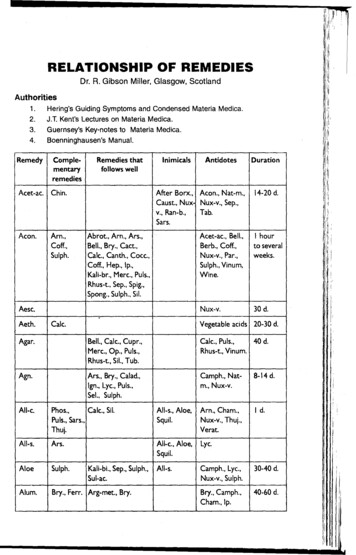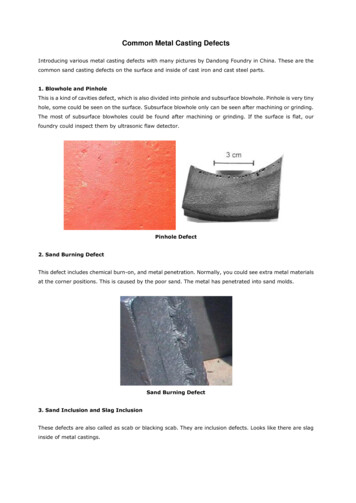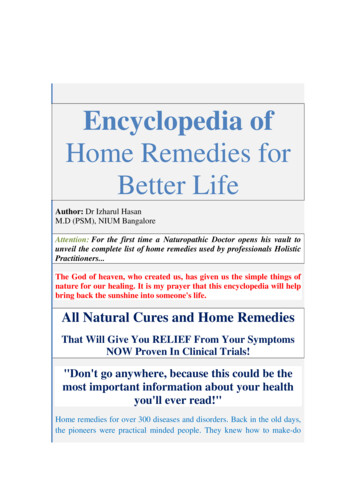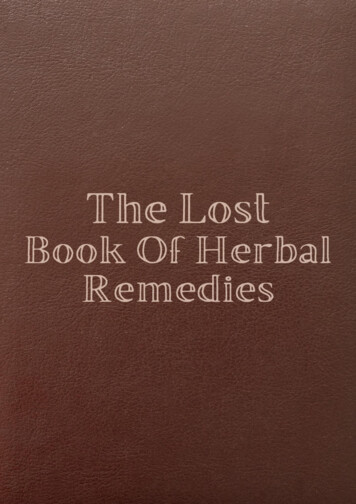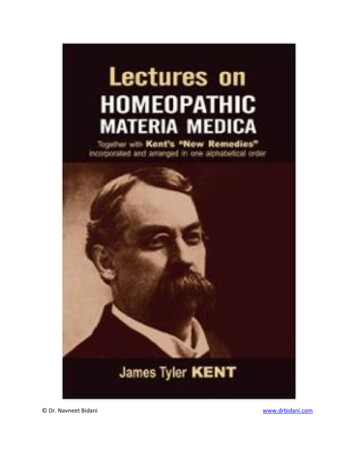
Transcription
Dr. Navneet Bidaniwww.drbidani.com
Courtesy:Serving Homoeopathy since 1960’shttp://drbidani.comAddress:DSB – 199, Red Square Market,Hisar – 125001. Haryana. INDIAMob: 91 9416336371E-mail: drbidani@gmail.com
LECTURES ON HOMOEOPATHIC PHILOSOPHYBYJames Tyler KENT, A.M., M.D.LECTURE 1 : Organon § 1. "The sick".Homoeopathy asserts that there are principles which govern the practice of medicine.It may be said that, up till the time of Hahnemann, no principles of medicine wererecognized, and even at this day in the writings and actions of the Old School there is acomplete acknowledgment that no principles exist.The Old School declares that the practice of medicine depends entirely upon experience,upon what can be found out by giving medicines to the sick.Their shifting methods and theories, and rapid discoveries and abandonment of the same,fully attest the sincerity of their acknowledgments and declarations.Homoeopathy leaves Allopathy at this point, and so in this manner the great divisionbetween the two schools is affected.That there are principles Homoeopathy affirms.The Old School denies the existence of principles and with apparent reason, looking atthe matter from the standpoint of their practice and methods.They deal only with ultimates, they observe only results of disease, and either deny orhave no knowledge of the real nature of man, what he is, where he came from, what hisquality is in sickness or in health.They say nothing about the man except in connection with his tissues ; they characterizethe changes in the tissues as the disease and all there is of the disease, its beginning andits end. In effect they proclaim disease to be something that exists without a cause.They accept nothing but what can be felt with the fingers and seen with the eyes orotherwise observed through the sense, aided by improved instruments.The finger is aided by the microscope to an elongated point, and the microscopicpathological results of disease are noted and considered to be the beginning and theending, i.e., results without anything prior to them.That is a summary of allopathic teaching as to the nature of sickness.But Homoeopathy perceives that there is something prior to these results.Every science teaches, and every investigation of a scientific character proves thateverything which exists does so because of something prior to it.Only in this way can we trace cause and effect in a series from beginning to end and backagain from the end to the beginning.By this means we arrive at a state in which we do not assume, but in which we know.The first paragraph of the Organon will be understood by an inexperienced observer tomean one thing and by a true and experienced homoeopath to mean another.Organon § 1."The physician's high and only mission is to restore the sick to health, to cure as it istermed."No controversy will arise from a superficial reading of this statement, and until.Hahnemann's hidden meaning of the word "sick" is fully brought to view, the physician
of any school will assent.The idea that one person will entertain as to the meaning of the word "sick" will bedifferent at times from that which another will entertain.So long as it remains a matter of opinion, there will be differences of opinion therefore,the homeopath must abandon the mere expressions of opinion.Allopathy rests on individual opinion and allopaths say that the science of medicine isbased on the consensus of opinion, but that is an unworthy and unstable foundation forthe science of curing the sick.It will never be possible to establish a rational system of therapeutics until we reasonfrom facts as they axe and not as they sometimes appear.Facts as they appear are ex pressed in the opinions of men, but facts as they are, are factsand truths from which doctrines are evolved and formulated which will interpret orunlock the kingdoms of nature in the realm of sickness or health.Therefore, beware of the opinion of men in science.Hahnemann has given us principles which we can study and advance upon.It is law that governs the world and not matters of opinion or hypotheses.We must begin by having a respect for law, for we have no starting point unless we baseour propositions on law.So long as we recognize men's statements we are in a state of change, for men andhypotheses change.Let us acknowledge the authority.The true homoeopath, when he speaks of the sick, knows who it is that is sick, whereasthe allopath does not know.The latter thinks that the house which the man lives in, which is being torn down,expresses all there is of sickness; in other words, that the tissue changes (which are onlythe results of disease, are all that there is of the sick man.The homoeopath observes wonderful changes resulting from potentized medicine andbeing compelled to reflect he sees that crude drugs cannot heal the sick and that whatchanges they do effect are not real but only apparent.Modern physiology has no vital doctrine in its teaching, and therefore no basis to workupon,The doctrine of the vital force is not admitted by the teachers of physiology and,therefore, the homoeopath sees that true physiology is not yet taught, for without the vitalforce without simple substance, without the internal as well as the external, there can beno cause and no relation between cause and effect.Now what is meant by "the sick ?"It is a man that is sick and to be restored to health, not his body, not the tissues.You will find many people who will say, "I am sick."They will enumerate pages of symptoms, pages of suffering.They look sick.But they tell you :"I have been to the most eminent physicians.I have had my chest examined.I have been to the neurologist.
I have been to the cardiac specialist and have had my heart examined.The eye specialist has examined my eyes.I have been to the gynecologist and have had my uterus examined", says the woman.I have been physically examined from head to foot, and they tell me I am not sick, I haveno disease."Many a time have I heard this story after getting three or four pages of symptoms.What does it mean ? It is true if that state progresses there will be evidences of disease,i.e., evidences which the pathologist may discover by his physical examination.But at present the patient is not sick, says the learned doctor, "But what do all thesesymptoms mean ? I do not sleep at night, I have pains and aches. My bowels do notmove.""Oh, well, you have constipation."That is the first thing that has been diagnosed.But do all these things exist without a cause ?It would seem from one opinion that the "constipation" is the disease per se, but fromanother opinion it would appear to be the cause of disease ; the "diagnosis" is made toapply to one as much as to the other.But this is the character of vagaries so common to Old School whims.These symptoms are but the language of nature, talking out as it were, and showing asclearly as the daylight the internal nature of the sick man or woman.If this state progresses the lungs break down.The doctor says, "Oh, now you have consumption; " or a great change appears in theliver, and he says, "Oh, now you have fatty degeneration of the liver; " or albumenappears in the urine, and he tells the patient. ".Now I am able to name your disease.You have some one of the forms of Bright's disease."It is nonsense to say that prior to the localization of disease, the patient is not sick.Does it not seem clear that this patient has been sick, and very sick, even fromchildhood ?Under traditional methods it is necessary that a diagnosis be made before the treatmentcan be settled, but in most cases the diagnosis cannot be made until the results of diseasehave rendered the patient incurable.Again, take the nervous child.It has wild dreams, twitching, restless sleep, nervous excitement, hystericalmanifestations, but if we examine all the organs of the body we will find nothing thematter with them.This sickness, however, which is present, if allowed to go on uncured, will in twenty orthirty years result in tissue change ; the organs will become affected and then it will besaid that the body is diseased ; but the individual has been sick from the beginning.It is a question whether we will start out and consider the results of disease or begin at thebeginning with the causes.If we have material ideas of disease we will have material ideas of the means of cure.If we believe an organ is sick and alone constitutes the disease, we must feel that if wecould remove the organ we would cure the patient.
A man has a necrotic condition of the hand ; then if we believe that only the hand is sickwe would think we had cured the patient by removing his hand.Say the hand is cancerous.According to this idea it is cancerous in itself and from itself, and seeing he would laterdie from the cancer of his hand we would conscientiously remove the hand and so curethe patient.For an eruption on the skin we would use local means to stimulate the functions of theskin and make it heal, and believing the eruption had no cause behind it we wouldconscientiously think we had cured the patient.But this is the reductio ad absurdum, for nothing exists without a cause.The organs are not the man.The man is prior to the organs.From first to last is the order of sickness as well as the order of cure.From man to his organs and not from organs to the man.Well, then who is this sick man ?The tissues could not become sick unless something prior to them had been deranged andso make them sick.What is there of this man that can be called the internal man ?What is there that can be removed so that the whole that is physical may be left behind ?We say that man dies but he leaves his body behind.We dissect the body and find all of his organs.Everything that we know by the senses belongs to physical man, everything that we canfeel with the fingers and see with the eyes he leaves behind.The real sick man is prior to the sick body and we must conclude that the sick man besomewhere in that portion which is not left behind.That which is carried away is primary and that which is left behind is ultimate.We say the man feels, sees, tastes, bears, he thinks and he lives but these are onlyoutward manifestations of thinking and living.The man wills and understands ; the cadaver does not will and does not understand ; thenthat which takes its departure is that which knows and wills.It is that which can be changed and is prior to the body.The combination of these two, the will and the understanding, constitute man ; conjoinedthey make life and activity they manufacture the body and cause all things of the body.With the will and understanding operating in order we have a healthy man.It is not our purpose to go behind the will and the understanding, to go prior to these.It is enough to say that they were created.Then man is the will and the understanding, and the house which he lives in is his body.We must, to be scientific homoeopaths, recognize that the muscles, the nerves, theligaments and the other parts of man's frame are a picture and manifest to the intelligentphysician the internal man.Both the dead and the living body are to be considered, not from the body to the life, butfrom the life to the body.If you were to describe the difference between two human faces, their character andeverything you observe of their action, you would be describing scarcely more than the
will.The will is expressed in the face ; its result is implanted on the countenance.Have you ever studied the face of an individual who has grown up a murderer or villainof some sort ?Is there no difference between his face and that of one who has the will to do good, tolive uprightly ?Go down into the lowest parts of our great city and study the faces of these people.These people are night prowlers ; they are tip late at night studying villainy.If we inquire into it we will see that their affections are of that kind.They have the stamp upon their faces.They have evil affections and an evil face.The countenance then is expressive of the heart.Allopathic pathology recognizes nothing but man's body.Yet one can easily confuse the allopath by asking him what man's thought is, what manis.The homoeopath must master these things before he can perceive the nature of the causeof disease and before he can understand what cure is.It is the sole duty of the physician to heal the sick.It is not his sole duty to heal the results of sickness, but the sickness, itself, when the manhimself has been restored to health, there will be restored harmony in the tissues and inthe activities.Then the sole duty of the physician is to put in order the interior of the economy i.e., thewill and understanding conjoined.Tissue changes are of the body and are the results of disease.They are not the disease.Hahnemann once said, "There are no diseases, but sick people," from which it is clearthat Hahnemann understood that the diseases so called, e.g., Bright's disease, liverdisease, etc. were but the grosser forms of disease results, viz., appearances of disease.There is first disorder of government, and this proceeds from within outward until wehave pathological changes in the tissues.In the practice of medicine today, the idea of government is not found, and the tissuechanges only are taken into account.He who considers disease results to be the disease itself, and expects to do away withthese as disease, is insane.It is an insanity in medicine, an insanity that has grown out of the milder forms of mentaldisorder in science, crazy whims.The bacteria are results of disease.In the course of time we will be able to show perfectly that the microscopical littlefellows are not the disease cause, but that they come after, that they are scavengersaccompanying the disease, and that they are perfectly harmless in every respect.They are the outcome of the disease, are present wherever the disease is, and by themicroscope it has been discovered that every pathological result has its correspondingbacteria.The Old School consider these the cause, but we will be able to show that disease cause is
much more subtle than anything that can be shown by a microscope.We will be able to show you by a process of reasoning, step by step, the folly of huntingfor disease cause by the implements of the senses.In a note, Hahnemann says :"The physician's mission is not, however, to construct so called systems, by interweavingempty speculations and hypotheses concerning the internal essential nature of the vitalprocesses and the mode in which diseases originate in the invisible interior of theorganism," etc.We know that in the present day people are perfectly satisfied if they can find the nameof the disease they are supposed to have, an idea cloaked in some wonderful technicality.An old Irishman walked into the clinic one day, and after giving his symptoms, said :"Doctor, what is the matter with me ?"The physician answered, "Why, you have Nux Vomica," that being his remedy.Where upon the old man said, "Well, I did think I had some wonderful disease or other."That is an outgrowth of the old fashioned folly of naming sickness.Except in a few acute diseases no diagnosis can be made, and no diagnosis need be madeexcept that the patient is sick.The more one thinks of the name of a disease so called the more one is beclouded in thesearch for a remedy, for then the mind is only upon the result of the disease, and not uponthe image expressed in symptoms.A patient of twenty five years of age, with gravest inheritances, with twenty pages ofsymptoms, and with only symptoms to furnish an image of sickness, is perfectly curableif treated in time.After being treated there will be no pathological results ; lie will go on to old age withoutany tissue destruction.But that patient if not cured at that early age will. take on disease results in accordancewith the circumstances of his life and his inheritances.If he is a chimney sweep he will be subject to the disease peculiar to chimney sweeps.If she is a housemaid she will be subject to the disease peculiar to housemaids etc.That patient has the same disease he had when he was born.This array of symptoms represents the same state before the pathological conditions havebeen formed as after.And it is true, if he has liver disease or brain disease or any of the many tissue changesthat they call disease, you must go back and procure these very symptoms before you canmake a prescription.Prescribing for the results of disease causes changes in the results of disease, but not inthe sickness except to hurry its progress.We will see peculiarities running through families.In the beginning is this primary state which is presented only by signs and symptoms, andthe whole family needs the same remedy or a cognate of that remedy ; but in one memberof the family the condition runs to cancer, in another to phthisis, etc., but all from thesame common foundation.This fundamental condition which underlies the diseases of the human race must beunderstood.
Without a knowledge of this it will be impossible to understand the acute miasmaticdiseases, which will be considered later.It is a well known fact that some persons are susceptible to one thing and some toanother.If an epidemic comes upon the land only a few come down with it.Why are some protected and why do others take it ?These things must be settled by the doctrines of Homoeopathy. Idiosyncrasies must beaccounted for.Many physicians waste their time searching after the things that make their patients sick.The sick man will be made sick under every circumstance, whereas the healthy mancould live in a lazaretto.It is not the principal business of the physician to be hunting in the rivers and the cellarsand examining the food we eat for the cause of disease.It is his duty to bunt out the symptoms of the sickness until a remedy is found that coversthe disorder.That remedy, which will produce on healthy man similar symptoms, is the master of thesituation, is the necessary antidote, will overcome the sickness, restore the will andunderstanding to order and cure the patient.To get at the real nature of the human economy, and to lead up from that to sickness,opens out a field for investigation in a most scientific way.Sickness can be learned by the study of the provings of drugs upon the healthy economy.Hahnemann made use of the information thus obtained when he stated that the mind isthe key to the man.The symptoms of the mind have been found by all his followers to be the most importantsymptoms in a remedy and in a sickness.Man consists in what he thinks and what he loves and there is nothing else in man.If these two grand parts of man, the will and understanding, be separated it meansinsanity, disorder, death.All medicines operate upon the will and understanding first (sometimes extensively onboth, affecting man in his ability to think or to will, and ultimately upon the tissues, thefunctions and sensations. In the study of Aurum we find the affections are most disturbedby that drug.Man's highest possible love is for his life. Aurum so destroys this that he does not lovehis life, he will commit suicide. Argentum on the other hand so destroys man'sunderstanding that he is no longer rational ; his memory is entirely ruined.So with every proved drug in the Materia Medica.We see them affecting first man's mind, and proceeding from the mind to the physicaleconomy, to the outermost, to the skin, the hair, the nails.If medicines are not thus studied you will have no knowledge of them that you can carrywith you. The Materia Medica has been established upon this basis.Sickness must therefore be examined by a thorough scrutiny of the elements that make upmorbid changes that exist in the likeness of drug symptoms.To the extent that drugs in provings upon healthy men have brought out symptoms onanimal ultimates must we study sickness with the hope of adjusting remedies to sickness
in man under the law of similars.Ultimate symptoms, function symptoms, sensorium symptoms and mind symptoms areall useful and none should be overlooked.The idea of sickness in man must be formed from the idea of sickness perceived in ourMateria Medica.As we perceive the nature of sickness in a drug image, so must we perceive the nature ofthe sickness in a human being to be healed.Therefore our idea of pathology must be adjusted to such a Materia Medica as wepossess, and it must be discovered wherein these are similar in order to heal the sick.The totality of the symptoms written out carefully is all that we know of the internalnature of sickness.Then the proper administration of the similar remedy will constitute the art of healing.LECTURE 2: Organon § 2 The highest ideal of a cure.The subject this morning relates to cure, to what the nature of a cure is.It is stated in the second paragraph of the Organon that :"The highest ideal of a cure is rapid, gentle and permanent restoration of the, health, orremoval and annihilation of the disease in its whole extent, in the shortest, most reliableand most harmless way, on easily comprehensible principles."If you were to ask a physician, who had not been trained in Homoeopathy, of what a cureconsists, his mind would only revolve around the idea of the disappearance of thepathological state ; if an eruption on the skin were the given instance, the disappearanceof the eruption from the skin under his treatment would be called a cure ; if hemorrhoids,the removal of these would be called a cure ; if constipation, the opening of the bowelswould be called a cure ; if some affection of the knee joint, an amputation above the kneewould be considered a cure ; or if it were an acute disease and the patient did not die, itwould be considered a cure of the disease.And that is really the idea of the patient as it is derived from the physician.The patient will often wonder at the great skill of the physician in removing an eruptionfrom the skin, and will go back again when the graver manifestations, the tissue changesthreatening death, have come on as a consequence, and will say to the doctor :" You so wonderfully cured me of my skin disease, why cannot you cure of my livertrouble ?"But this very scientific ignorant doctor has made a failure ; he has driven what was uponthe surface and harmless into the innermost precincts of the economy and the patient isgoing to die as a result of scientific ignorance.There are three distinct points involved in this paragraph and these must be brought out.Restoring health, and not the removing of symptoms, is the first point.Restoring health has in view the establishment of order in a sick human being ; removingsymptoms has not in view a human being ; removing the constipation, the hemorrhoids,the white swelling of the knee, the skin disease or any local manifestation or particularsign of disease, or even the removal of a group of symptoms does not have in view therestoration to health of the whole economy of man.
If the removal of symptoms is not followed by a restoration to health, it cannot be calleda cure.We learned in our last study that " the sole duty of the physician is to heal the sick," andtherefore it is not his duty merely to remove the symptoms, to change the aspect of thesymptoms the appearance of the disease image, imagining that lie has thereby establishedorder.What a simple minded creature he must be !What a groveller in muck and mire he must be, when he can meditate upon doing suchthings, even a moment !How different his actions would be if he but considered that every violent change whichbe produces in the aspect of the disease aggravates the interior nature of the disease,aggravates the sickness of the man and brings about an increase of suffering within him.The patient should be able to realize by his feelings and continue to say, that he is beingrestored to health, whenever a symptom is removed.There should be a corresponding inward improvement whenever an outward symptomhas been caused to disappear, and this will be true whenever disease has been displacedby order.The perfection of a cure consists, then : first in restoring health, and this is to be donepromptly, mildly and permanently, which is the second point.The cure must be quick or speedy, it must be gentle, and it must be continuous orpermanent.Whenever an outward symptom has been caused to disappear by violence, as bycathartics to remove constipation, it cannot be called mild or permanent, even if it isprompt.Whenever violent drugs are resorted to there is nothing mild in the action or the reactionthat must follow.At the time this second paragraph of the Organon was written physicking was not so mildas at the present day ; bloodletting, sweating, etc., were in vogue at the time Hahnemannwrote these lines.Medicine has changed somewhat in its appearance ; physicians are now using sugar coated pills and contriving to make medicines appear tasteless or tasteful ; they are usingconcentrated alkaloids.But none of these things have been done because of the discovery of any principle ;blood letting and sweating were not abandoned on account of principle, for the old mendeprecate their disuse, and often say they hope the time will come when they can againgo back to the lancet.But the drugs of today are ten times more powerful than those formerly used, becausemore concentrated.The cocaine, sulphonal and numerous other modern concentrated products of themanufacturing chemists are extremely dangerous and their real action and reactionunknown.The chemical discoveries of petroleum have opened a field of destruction to humanintelligence, to the understanding and to the will, because these products are slowly andinsidiously violent.
When drugs were used that were instantly dangerous and violent the action was manifest,it showed upon the surface, and the common people saw it.But the patient of the present day goes through more dangerous drugging, because itdestroys the mind.The apparent benefits produced by these drugs are never permanent.They may in some cases seem to be permanent, but then it is because upon the economyhas been engrafted a new and most insidious disease, more subtle and more tenaciousthan the manifestation that was upon the externals and it is because of this tenacity thatthe original symptoms remain away.The disease in its nature, its esse, has not been changed ; it is still there, causing theinternal destruction of the man, but its manifestation has been changed, and there hasbeen added to this natural disease a drug disease, more serious than the former.The manner of cure can only be mild if it flows in the stream of natural direction,establishing order and thereby removing disease.The direction of old fashioned medicine is like pulling a cat up a hill by the tail ;whereas, the treatment that is mild, gentle and permanent, flows with the stream, scarcelyproducing a ripple ; it adjusts the internal disorder and the outermost of man returns toorder.Everything becomes orderly from the interior.The curative medicine does not act violently upon the economy, but establishes its actionin a mild manner ; but while the action is mild and gentle, very often that which follows,which is the reaction, is a turmoil, especially when the work of traditional medicine isbeing undone and former states are being re established.The third point is "upon principles that are at once plain and intelligible."This means law, it means fixed principles ; it means a law as certain as that ofgravitation ; not guess work, empiricism, or roundabout methods, or a cut and dried useof drugs as laid down by the last manufacturer.Our principles have never changed, they have always been the same and will remain thesame.To become acquainted with these principles and doctrines, with fixed knowledges, withexactitude or method, to become acquainted with medicines that never change theirproperties, and to become acquainted with their action, is the all important aim inhomoeopathic study.When one has learned these principles, and continues to practice them, they growbrighter and stronger.The use of these fixed principles is the removal of disease, the restoration to health in amild, prompt and permanent manner.If one were to ask an allopathic graduate in this class how he could demonstrate that hehad cured some body, the answer could only be such as I have mentioned already , viz.,the patient did not die, or that the manifestations prescribed for had disappeared.If one were to ask to a physician trained in homoepathic principles the same question, onewould find that there are means of distinctly demonstrating why he knows his patient isbetter.You would naturally expect, if it is the interior of man that is disordered in sickness, and
not his tissues primarily, that the interior must first be turned into order and the exteriorlast.The first of man is his voluntary and the second of man is his understanding, the last ofman is his outermost ; from his center to his circumference, to his organs, his skin, hair,nails, etc.This being true, the cure must proceed from center to circumference.From center to circumference is from above downward, from within outwards, from moreimportant to less important organs, from the head to the hands and feet.Every homoeopathic practitioner who understands the art of healing, knows thatsymptoms which go off in these directions remain away permanently.Moreover he knows that symptoms which disappear in the reverse order of their comingare removed permanently.It is thus he knows that the patient did not merely get well in spite of the treatment, butthat he was cured by the action of the remedy.If a homoeopathic physician goes to the bedside of a patient and, upon observing theonset of the symptoms and the course of the disease, sees that the symptoms do notfollow this order after his remedy, he knows that he has had but little to do with thecourse of things.But if on the contrary, he ob
LECTURES ON HOMOEOPATHIC PHILOSOPHY BY James Tyler KENT, A.M., M.D. LECTURE 1 : Organon § 1. "The sick". Homoeopathy asserts that there are principles which govern the practic
